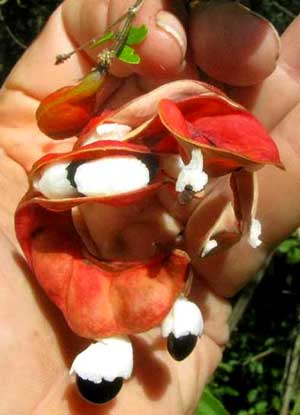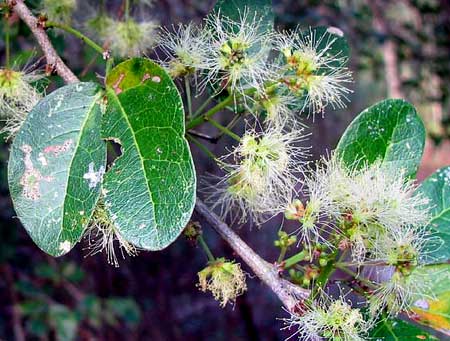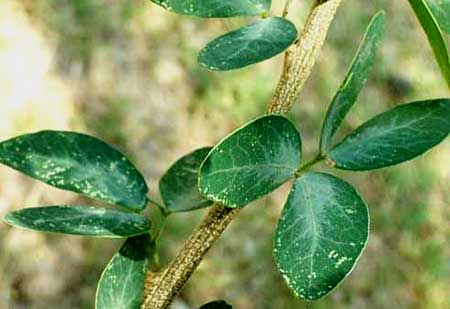BLACKBEADS
 Throughout the year but mostly at the end of the dry season in April or so a medium-sized tree that's easy to overlook the rest of the year suddenly develops curled, red bean-pods, or legumes. Two such legumes curling together and splitting open to release their black beans partly encased in white tissue are shown at the right.
Throughout the year but mostly at the end of the dry season in April or so a medium-sized tree that's easy to overlook the rest of the year suddenly develops curled, red bean-pods, or legumes. Two such legumes curling together and splitting open to release their black beans partly encased in white tissue are shown at the right.
The tree producing these legumes is Pithecellobium dulce, a fairly common tree from southern Mexico into northern South America. In some cultures the legumes are appreciated because the white tissue cupping the black beans is somewhat sweet and very edible. Sometimes people secure hooks on poles for snatching the pods just so they can stand around nibbling on them. Technically the white tissue is referred to as the aril, which is a growth arising from the threadlike connection between the bean and the pod.
Finding a good English name for Pithecellobium dulce is impossible. Many books list it as Manila Tamarind, but the species is neither from Manila nor is it a tamarind. It's also called Madras Thorn, but it's not from Madras, either. This native Mexican species has been carried to many tropical countries throughout the world, which accounts for the many names, but for us in the Yucatan they are inappropriate. Spanish speakers don't seem to have a consistently used name for it. My Maya friends call the tree, approximately, Ts'iu-Ché. Well, several species of Pithecellobium exist and members of the genus sometimes are referred to as Blackbeads, so that's what we'll call them here: Blackbeads.
Another nice thing about Blackbeads is that in the middle of the dry season, in February or thereabouts, they become covered with white, fuzzy-looking flowers, as shown below.
Below, you have a better look at the tree's curious leaves.
As is typical for the Bean Family, the leaves are compound. In this case they are doubly compound. Usually doubly compound leaves consist of very many tiny leaflets, like the acacias, but in this species the leaf's first division produces only two subdivisions, then each subdivision forms only two leaflets. Therefore there are four egg-shaped leaflets per leaf.
 Throughout the year but mostly at the end of the dry season in April or so a medium-sized tree that's easy to overlook the rest of the year suddenly develops curled, red bean-pods, or legumes. Two such legumes curling together and splitting open to release their black beans partly encased in white tissue are shown at the right.
Throughout the year but mostly at the end of the dry season in April or so a medium-sized tree that's easy to overlook the rest of the year suddenly develops curled, red bean-pods, or legumes. Two such legumes curling together and splitting open to release their black beans partly encased in white tissue are shown at the right.
